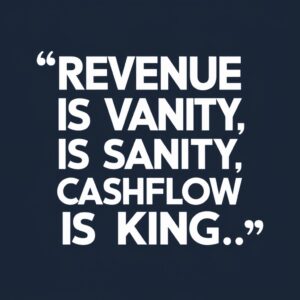In theory, businesses get more profitable as revenue increases – for obvious reasons relating to purchasing power and operational efficiency. And yet many owners of growing businesses don’t experience this and are left wondering why their larger business is not generating enough profit and cash.
If this is where you are with your business – a bigger payroll, more costs, more admin and not enough left over to justify the additional risk and stress – this article is for you.
Cost Cutting Will Only get you So Far

I like the simplicity (and accuracy) of the old saying that “revenue is vanity, profit is sanity, cashflow is king”, but I recognise that it’s not very practical. It doesn’t trigger enough specific ideas of what you can actually do to act on it.
If you’ve ever gone through a period of more than a week or two spending money on a debit card and keeping track of your spending in your head, you’ll know that the amount you’ve spent is always higher than you thought.
Equally, if you’ve ever looked at what you spend in a year on a chart, I can pretty much guarantee that you’ll have immediately made changes to your spending habits and priorities.
Perhaps this is why the natural response of many business owners facing dribbling cashflow is to think of cutting costs.
But whilst cost control is a non-negotiable of business success, it only represents a fraction (1/7th to be precise) of the picture.
So, if cashflow is the problem, what is the answer?
There are 7 internal variables that determine the health of cash in a business – in other words not counting funding, loans or overdrafts.
If you view your business as a pipeline, these would be the 7 ‘stops’ you can open up to maximise the amount of money that makes it all the way through to becoming net cashflow.
We’ll detail them shortly, but first let’s properly frame the solution to this problem. It’s best to look at it as a 3-step process.
- Understanding the 7 Levers
- Getting clarity about which ones will have the biggest potential to improve cashflow in your business
- How to measure – in tangible terms – the effectiveness of your solutions & actions
Step 1: Understanding the 7 Levers to Control Net Cashflow
1 – Pricing:
This is exactly as it sounds – how much you charge for your product or service. As a general rule of thumb, businesses I speak to tend towards under-charging. They also focus too much on the product and not enough on value-added and service, which has the effect of increasing perceived pricing pressure.
2 – Volume (Revenue):
This is a function of new and repeat customers and how many products they buy – for how long and how often. Ie Marketing & Sales (plus Product Ladder and Customer Service)
3 – COGS (Cost of Goods Sold):
These are your Variable Costs – the direct costs of providing your product or service. If you’re making stuff (say, furniture) the list will be long and heavy on £ – if you’re in a service industry (say, an architect or accountant) it’ll be short and light.
4 – Overheads:
These are your Fixed Costs. In other words, what you pay whether you have any customers or not. If it’s on a recurring debit, it’s probably a fixed cost. This is where the majority of service-industry costs appear. Staff costs for revenue earners in a service industry are the equivalent of a physical product, they just appear under a different heading in your accounts.
5 – Accounts Receivable Days:
This is the average number of days it takes to get paid. This is hugely important for any business but especially if you have what’s known as a ‘cash gap’, This is where you are paying out before you provide the product and then invoicing later.
6 – Inventory Days:
This is a function of the amount of stock you hold and on average how long it takes to sell it. (For a service company this is WIP – Work in Progress but not yet invoiced). This is one of the areas that tends to get proportionately bigger as businesses grow – partly due to increased ranges of product – and partly due to lack of focus.
7 – Accounts Payable:
This is on average how long it takes you to pay your invoices – the later you pay the better for your cashflow. Although I never focus on this as it’s unfair on other business owners and what goes around tends to come around.
And that’s it.
These are the only 7 Levers or variables that you (the MD / CEO and your management team) can directly control to determine how effectively you convert potential customers into revenue, gross profit, net profit – and finally, most importantly, into cash.
NB: I’ve put together a session for senior leadership teams to tease out ideas to improve these variables. Having run it for many clients over the years it always has a huge impact.
Step 2: Understanding which of the 7 levers will have the biggest impact on net cashflow for your business.
This is the most important of the 3 steps.
If you know precisely what (in terms of hard cash) is up for grabs, you’ll have started down the road to fixing it.
I use a bespoke piece of software called ActionCASH to do this (created with the team at MyCashFlow Story).
It’s driven by 19 numbers from your P&L, Cashflow Statement & Balance Sheet and you’ll need a minimum of three full-year sets of numbers to produce a compelling report – and ideally four. It takes in the region of an hour in total to set up – 20 mins each for you, your accountant and me.
60 mins in exchange for a degree of clarity on net cashflow that many large businesses do not have.
Your profile will clearly isolate:
- The 7 levers for your business and the impact they have on net cashflow
- Your financial story in 4 chapters covering P&L, Cashflow, Balance Sheet & Funding
- Your business valuation – and how changes to the 7 Levers impacts it
The Power of One
ActionCASH contains one of the most compelling and valuable financial modelling tools I have ever seen: The Power of One.
Clear, simple and easy to use, this allows you to play around with % increases and decreases in each of the 7 Levers, and ‘live model’ what happens to operating profits and more importantly net cashflow.
At a simple level, you might want to know:
- What happens to cash flow if we put our prices up by 1%, 2%, 3% etc?
- Is it more cash-effective to focus on volume or price?
- What happens to net cashflow if we get paid on average 3 days sooner?
- Or keep on average 3 days less stock?
At a slightly deeper level we could model:
- How many customers could we lose if we increased prices by eg 5% and still make the same operating profit?
- To what degree would getting paid sooner to reduce our borrowing requirements?
- What would happen to the valuation of the business if we increased prices or new customers by eg 5%?
This is a degree of insight that matches anything even the largest businesses have.
It will give you total clarity on where you need to devote your resources of people, time and money to get the biggest return.
It puts you in the driving seat of your business.
CHALLENGE #3: Measuring how effective (in hard cash) how each of your actions has been
Ultimately, you’ll find the measure of success in your company bank accounts.
This is great, but of limited ongoing value as a management tool. Cash balances – even healthy ones – do not tell you how to go about building on those successes.
With this software you’ll be able to break this down and understand what has worked – and to what extent – and what hasn’t.
We can generate reports modelling different scenarios and outcomes, save each of them as a pdf and then use them to compare what happens versus expectations & targets.
NB For added clarity and focus, pick the most important 3 numbers for your business, track them long-term on a chart and properly review them as a management – regularly. I’ve got a great structure I can share to help you make this happen.
CONCLUSION

Business cycles are like seasons – the times of plenty come and go just the same as winter. Having said that, economic uncertainty and everything that brings appears to have taken up semi-permanent residence on the business landscape. At least for the time being.
When you add in the potential impact of AI, it’s down to all of us who run businesses to plan for tough times well in advance.
Tough times tend to lead to the same response in business: viewing marketing investment as a cost and reducing it.
This is akin to saving money by not eating. It works well in the very short term – before leaving you with a much bigger set of problems.
The solution is to maximise cashflow at every stage of growth and in every economic season.
Which could in the end make all the difference.
All the best, Tim
P.S. If you’re ready to take action and want to look at this for your business, please do get in touch.


